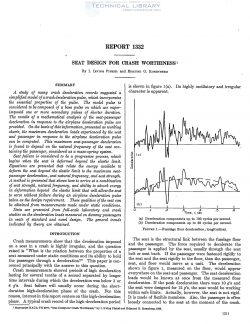naca-report-1332
- Version
- 192 Downloads
- 1.47 MB File Size
- 1 File Count
- November 2, 2016 Create Date
- November 2, 2016 Last Updated
National Advisory Committee for Aeronautics, Report - Seat Design for Crash Worthiness

A study of many crash deceleration records suggested a
simplified model of a crash deceleration pulse, which incorporates
the essential properties of the pulse. The model pulse is
considered to be composed of a base pulse on which are super—
imposed one or more secondary pulses of shorter duration.
The results of a mathematical analysis of the seat-passenger
deceleration in response to the airplane deceleration pulse are
provided. On the basis of this information, presented as working
charts, the maximum deceleration loads experienced by the seat
and passenger in response to the airplane deceleration pulse
can be computed. This maximum seat-passenger deceleration
is found to depend on the natural frequency of the seat con-
taining the passenger, considered as a mass-spring system.
Seat failure is considered to be a progressive process, which
begins when the seat is deformed beyond the elastic limit.
Equations are presented that relate the energy available to
deform the seat beyond the elastic limit to the maximum seat—
passenger deceleration, seat natural frequency, and seat strength.
A method is presented that shows how to arrive at a combination
of seat strength, natural frequency, and ability to absorb energy
in deformation beyond the elastic limit that will allow the seat
to serve without failure during an airplane deceleration pulse
taken as the design requirement. These qualities of the seat can
be obtained from measurements made under static conditions.
Data are presented from full—scale laboratory and crash
studies on the deceleration loads measured on dummy passengers
in seats of standard and novel design. The general trends
indicated by theory are obtained.
Crash measurements show that the deceleration imposed
on a seat in a crash is highly irregular, and the question
raised is “What is the relation between the properties of a
seat measured under static conditions and its ability to hold
the passenger through a deceleration?” This paper is con-
cerned principally with the answer to this question.
Crash measurements showed periods of high deceleration
lasting for several tenths of a second separated by longer
time intervals during which the deceleration was below 3 or
4 g’s. Seat failure will usually occur during the short—
duration high—deceleration phase of the crash. For this reason,
interest in this report centers on this high-deceleration phase.
| File | Action |
|---|---|
| naca-report-1332 Seat Design for Crash Worthiness.pdf | Download |

Comment On This Post